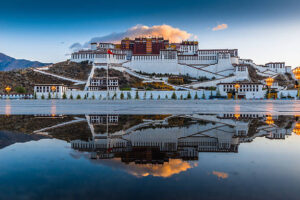Tibetan Landmark Potala Palace Cultural Guide (2025)
Diverse Values of Potala Palace
a. Architectural Marvel
Perched majestically at 3,700 meters above sea level, the Potala Palace dominates Lhasa's skyline with its imposing 13-story structure housing over 1,000 rooms - making it the world's highest and most awe-inspiring ancient palace complex. Recognized as a UNESCO World Heritage Site in 1994, this architectural masterpiece brilliantly divides into the White Palace, with its administrative halls and living quarters glowing like a pearl in the morning sun, and the Red Palace, where countless religious shrines shimmer with golden ornaments. What makes it truly remarkable is its traditional Tibetan construction - built entirely without nails using ingenious techniques of rammed earth, wood, and stone that have withstood centuries of harsh plateau winds. The palace's walls, sloping inward at 13 degrees, demonstrate ancient builders' profound understanding of seismic resistance.
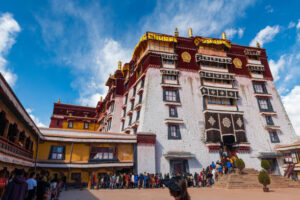
b. Window into Civilization
More than just a building, the Potala Palace stands as the living heart of Tibetan civilization. Within its sacred walls reside an astonishing collection of 10,000 gilded stupas, 698 vibrant murals that seem to breathe with history, and priceless artifacts like the handwritten Kangyur scriptures in liquid gold ink. The Gold Roof Tombs, glowing like celestial chambers, enshrine the relics of past Dalai Lamas, their jewel-encrusted surfaces reflecting 1,300 years of unbroken spiritual and political legacy.
c. Echoes of History
The palace's stones remember everything - from its 637 CE founding by visionary King Songtsen Gampo to welcome Princess Wencheng, to its transformation into Tibet's political-religious nerve center. Local guides still point out the legendary "Dharma Cave," where Songtsen Gampo reportedly meditated, and speak in hushed tones of secret tunnels said to connect to sacred Mount Chakpori. The walls come alive with murals depicting pivotal moments like the historic Tibetan-Chinese Tang dynasty alliance, where Princess Wencheng's procession is frozen in time with such detail you can almost hear the ceremonial horns.
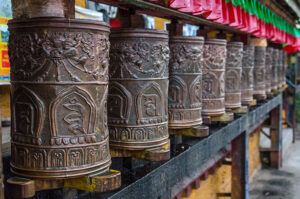
d. Pulse of Faith
As dawn breaks over the Himalayas, the palace awakens to the rhythmic murmur of prayers and the soft chime of turning prayer wheels. Pilgrims in traditional chubas circle the palace in a sacred kora, their foreheads dusted with earth from full-body prostrations, creating an unbroken chain of devotion that has continued for centuries. Visitors often speak of unexpected moments of clarity here, when a shaft of sunlight through incense smoke or the sudden harmony of ritual horns strikes the soul with timeless wonder.
Highlight Elements
a. Architectural Nuances
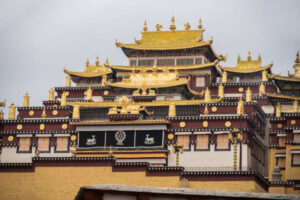
-
White & Red Symbolism
The "milk walls" of White Palace glow with honeyed warmth under the sun, embodied of Avalokiteshvara’s compassion. And the deep crimson of Red Palace is woven from penma grass (willow that thrives at 3,700m), symbolizing unshakable spiritual power.
-
Mandala Layout
The pilgrimage from East Gate to golden roofs follows a sacred geometry: walk corridors painted with samsara cycles (earthly realm), climb 108 steep steps (human afflictions), finally reach the Mandala Chapel. This spiral ascent turns physical effort into spiritual awakening.
-
Golden Roofs
Gilded with 3.7 tons of gold, while genius hides in details: Makara gargoyles on eaves have sonic conduits as their jaws, which chant Tara mantras in the wind. And when dawn hits the Deer-and-Wheel gilded pinnacle, shadow deer "walk’"across walls.
-
Hidden Dharma Wheels:
Above every doorway, tiny dharma wheels flanked by Eight Auspicious Signs form "wisdom portals". Locals believe bowing through them spins karma into light.
b. Treasures & Murals
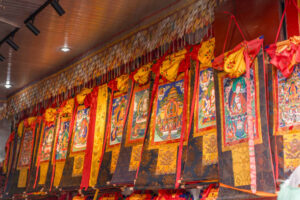
-
Fifth Dalai Lama’s Stupa
The 14.85-meter Pearl Stupa dazzles with 18,670 pearls and amber, but its ivory pinnacle holds the wonder: glowing softly in darkness. Craftsmen call it ‘rainbow body light’, while scientists detected rare jeremejevite crystals inside.
-
Princess Wencheng Mural
In the Dharma King’s Cave, the Tang Dynasty mural of Princess Wencheng’s caravan reveals secrets: her Han-style Buddha statue (now in Jokhang) glows with gold leaf, while pleats in her skirt hide micro-mountains and rivers.
-
Medical Thangka: Ancient murals detail Tibetan herbal remedies and anatomy.
The 79 medical thangkas in White Palace are Tibetan science masterpieces. Golden meridians map human anatomy, while diseases manifest as demons. And you can breathe in the real scent of herbs near the saffron illustration, as its essence in pigments releases when humid.
-
Kalachakra Mandala
The 6-meter Kalachakra Mandala astounds, woven with 300 silk hues and gold threads containing Buddha’s hair which is visible under microscope. Every leap year, monks disassemble and reweave it — folding time with their hands, renewing cosmic wisdom stitch by stitch.
Cultural Experience
a. Capture Your Tibetan Moment
-
Nomadic Soul: Dress in authentic yak-wool chuba with turquoise headdress at Yunzangyuan Studio (5 Zangyiyuan Rd). Their herder-style photoshoots include sheepskin prayer wheels. (¥300-500)
-
Mandala Elegance : Channel mural goddesses in brocade robes at Tihuo Art Space (east of Potala). Their museum-replica costumes shine against Red Palace windows. (¥600-900)
b. Hands-On Heritage
-
Grinding Enlightenment: At Fanyu Thangka Center (near Jokhang), grind malachite into pigment with yak milk, paint a mini mandala guided by masters—meditation through art. (¥150/2hr)
-
Craft Sacred Scents: Blend saffron, snow lotus & 36 herbs into incense sticks at Guxiuna Bookhouse. Press them in juniper wood molds—take home your Himalayan fragrance in yak-leather pouches.(¥80/1.5hr)
-
Mask of Deities: Paint opera masks with Lhoka artists at Norbulingka Workshop. (¥120)
c. Souvenirs with Soul
-
Mandala in a Vial (¥180-380)
The official Potala shop sells sand mandala vials handcrafted by monks. Mini versions preserve cosmic patterns in 0.5mm precision—eternal beauty in your palm.
📍North Exit Hall | ⏰10AM-6PM
-
Himalayan Herbal Charm (¥45)
Ganlu Tibetan Pharmacy makes anti-altitude sachets with snow lotus & rhodiola. Sniff when climbing Yamdrok Lake—my headache vanished! Buy 3 get 1 free for squad goals.
📍No. 12 Yutuo Road | ⏰9AM - 9PM
-
Carved Barley Wine Set (¥220)
Find yak-bone chang sets at Jophelin Workshop. Silver inlays chime when pouring barley wine—perfect for hosting Tibetan nights back home.
📍2nd Floor, Courtyard 3, East Barkhor Street | ⏰11AM - 7PM
Travel Tips
a. Opening Hours
-
Peak season (May–Oct): 09:00–17:00 (last entry 15:00).
-
Off-season (Nov–Apr): 09:30–15:30. Closed Sundays.
b. Tickets & Booking
-
Price: CNY 200 (peak), CNY 100 (off-season).
-
Reservation: Book 7 days ahead via Potala Palace’s official WeChat or website. Foreign passports require on-site verification.
c. Clothing & Gear
Wear layers; indoor stairs lack heating. Bring UV-blocking sunglasses and a hat.
d. Seasonal Guide
-
Spring (Apr–May): Crisp air, fewer crowds.
-
Summer (Jun–Aug): Warm but crowded; book early.
-
Autumn (Sep–Oct): Golden light and clear skies.
-
Winter (Nov–Mar): Snow accents with quiet ambiance.
e. Preventing Altitude Sickness
With Potala Palace sitting at 3,656m, altitude sickness is real but manageable. Here’s how to enjoy Tibet safely:
-
Climb slow: Spend 1-2 days in Lhasa (3,650m) before going higher.
-
Hydrate like it’s your job: Drink 4L water daily – dehydration is your enemy!
-
Ditch alcohol & heavy meals for 48 hours after arrival.
-
Pack Diamox (acetazolamide) – start taking it 24h before flying in (consult your doctor).
-
Wear a scarf – cold air triggers headaches.
Stay & Transport
a. Accommodation
-
Barkhor Area (10-min walk): Budget guesthouses (CNY 150–300) and boutique hotels (CNY 600+).
-
Beijing Road (15-min walk): Mid-range options (CNY 400–800) with mountain views.
b. Getting There
-
Bus: Take 8, 13, or 24 to *"Potala Palace East Station"*.
-
Taxi: CNY 15–20 from downtown. Pre-arranged rides advised for foreigners.
Special Notes for Foreigners
a. Permits
-
Tibet Travel Permit: Mandatory; obtained via a registered agency.
-
Palace Entry: Present passport and permit for ticket collection.
b. Rules
-
No photos inside shrines; follow fixed visitor routes.
-
Backpacks prohibited; lockers provided (CNY 5).
c. Etiquette
-
Walk clockwise around stupas; don’t point at sacred objects.
-
Cover knees and shoulders indoors.
Claim Your Breathless Moment: Journey to Potala Palace Now
Potala Palace transcends time as a beacon of Tibet’s soul—where architecture, faith, and history converge. From its gilded rooftops to pilgrims’ murmured prayers, this UNESCO treasure offers an unparalleled journey into the Himalayas’ spiritual core. Prepare to leave breathless, both by its altitude and its majesty.
